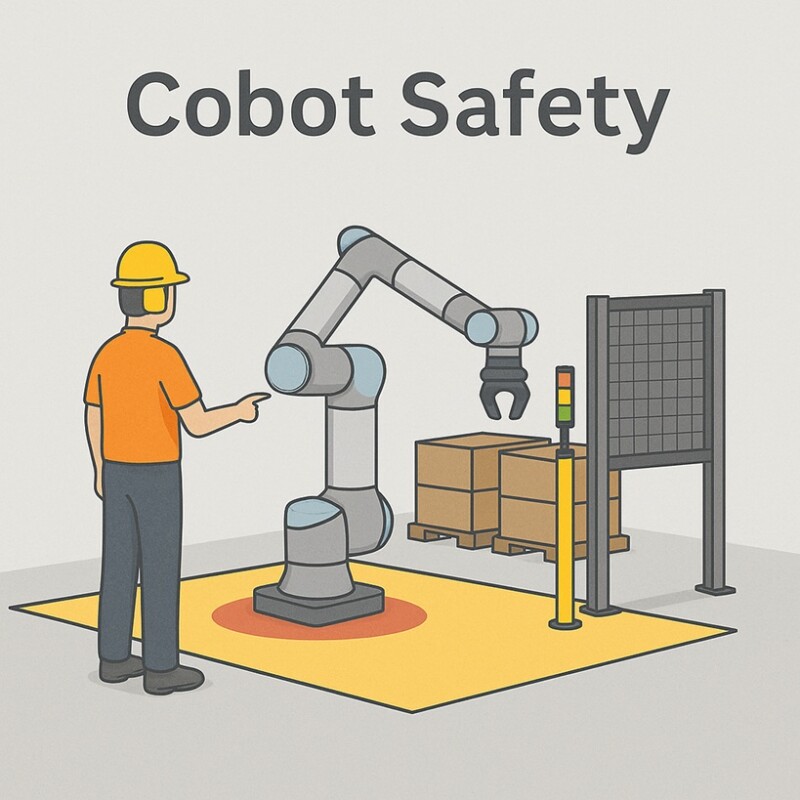10 Cobot Safety Mistakes SMEs Still Make — And How to Fix Them
Collaborative robots (cobots) have become affordable, flexible, and easy to deploy — which makes them especially attractive for small and medium enterprises (SMEs). But even as cobots promise “safe by design” operation, many installations fall short of international safety standards. Here are the ten most common cobot safety mistakes SMEs still make, along with practical fixes that won’t break your budget.
1. Skipping a Proper Risk Assessment
Too many cobots go live without a documented risk assessment. Every task and motion must be analyzed to identify potential hazards. Follow ISO 12100 and ISO/TS 15066 to assess contact points, speeds, and forces. Without this, you can’t prove compliance — or protect operators.
2. Treating Cobots as “Inherently Safe”
Cobots are not automatically safe. Even with force-limiting joints, heavy payloads, sharp tools, or high speeds can make them dangerous. A “safe” cobot can become unsafe with the wrong end-effector or workpiece. Always validate against ISO/TS 15066 thresholds.
3. Ignoring Tooling and Workpiece Risks
End-effectors are often overlooked. A gripper with sharp fingers, vacuum cups that eject parts, or cutting tools can all introduce new hazards. Every tool and workpiece must be included in your risk documentation — especially when retooling the cobot for a new job. Consider also integrating digital twins to simulate tooling impact and ensure safety before physical testing.
4. Overriding Safety Settings for Productivity
Operators sometimes disable scanners or increase speeds to meet output targets. This defeats the purpose of safety validation. Modern cobots can include “smart zones” — allowing faster motion only when humans are outside the workspace. Use these features instead of overrides, and review guidance on Functional Safety (PL/SIL) to ensure your settings meet proper safety integrity levels.
5. Poor Placement of Safety Devices
Even well-intentioned setups fail if sensors or light curtains are misplaced. Install safety scanners at the correct distance, with clear field of view and no blind spots. Modular fencing and floor markings help guide operator movement and reduce false stops.
6. Failing to Revalidate After Changes
Whenever a cobot’s speed, gripper, or workspace changes, the original risk assessment becomes invalid. A quick 30-minute revalidation using simple force and speed tests ensures continued compliance and avoids future liability.
7. Forgetting Operator Training
Training is often the cheapest and most effective safety control. Operators should understand how to recognize scanner zones, interpret visual indicators, and respond to stop conditions. Schedule short quarterly refreshers — it’s an investment in uptime, not a cost. Consider integrating workforce upskilling and AR-based safety training to make sessions more effective.
8. Neglecting Maintenance on Safety Systems
Safety scanners, sensors, and relays can drift or fail over time. Preventive maintenance should include periodic sensor alignment checks, firmware updates, and validation of emergency stop performance. Automated health diagnostics, where available, reduce manual testing effort. Learn from predictive maintenance models used in process industries — the same logic applies to cobot safety verification.
9. Forgetting Documentation and Traceability
Without evidence, safety doesn’t exist in the eyes of an auditor. Keep all risk assessments, validation results, and maintenance logs accessible. Digital documentation tools simplify audits and support traceability for years of operation.
10. Not Planning for Future Scalability
SMEs often deploy cobots as one-off projects without thinking about scale. Choose safety architectures (e.g., modular fencing, shared scanners, or centralized safety PLCs) that can grow with your production line. For guidance, see Cobot Cells That Scale: Modular Fencing, Light Curtains, and Safe Sensors.
Bonus: Digital Safety Monitoring
Some manufacturers are now leveraging AI-based analytics to detect abnormal cobot behavior. By tracking torque, force, and speed deviations, predictive systems can warn operators before a safety incident occurs.
Related Articles in the Cluster
- Cobot Safety in 2025: A Practical Playbook for Fast, Compliant Deployments
- From Risk Assessment to Run Time: How to Make Collaborative Robots Truly Safe
- ISO/TS 15066 in Plain English: Force Limits, Tooling, and Real-World Examples
- Cobot Cells That Scale: Modular Fencing, Light Curtains, and Safe Sensors
- Predictive Maintenance 2025: Sensors, Signals, and Real ROI
- Workforce Upskilling in Smart Factories: How to Train for Automation
Quick Q&A: Everyday Safety Lessons
Q: What’s the fastest way to detect unsafe cobot motion?
A: Compare live torque data to baseline signatures — unexpected spikes usually mean collision or overload.
Q: How do you prove a cobot is “safe enough”?
A: Only through documented validation under ISO 10218 and ISO/TS 15066. Claims without data don’t count.
Q: Should SMEs hire external safety consultants?
A: If in-house expertise is limited, yes. A short expert audit often prevents months of lost production.
Conclusion
Collaborative robots make automation accessible for SMEs, but safety shortcuts can erase all the benefits. By avoiding these ten mistakes — and focusing on documentation, validation, and training — manufacturers can deploy cobots faster, safer, and with long-term confidence.









































Interested? Submit your enquiry using the form below:
Only available for registered users. Sign In to your account or register here.